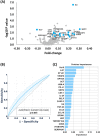High dietary inflammatory index associates with inflammatory proteins in plasma
- PMID: 38409061
- PMCID: PMC10895728
- DOI: 10.1186/s13098-024-01287-y
High dietary inflammatory index associates with inflammatory proteins in plasma
Abstract
Background and aim: Unhealthy dietary habits and highly caloric foods induce metabolic alterations and promote the development of the inflammatory consequences of obesity, insulin resistance, diabetes and cardiovascular diseases. Describing an inflammatory effect of diet is difficult to pursue, owing lacks of standardized quali-quantitative dietary assessments. The Dietary Inflammatory Index (DII) has been proposed as an estimator of the pro- or anti-inflammatory effect of nutrients and higher DII values, which indicate an increased intake of nutrients with pro-inflammatory effects, relate to an increased risk of metabolic and cardiovascular diseases and we here assessed whether they reflect biologically relevant plasmatic variations of inflammatory proteins.
Methods: In this cross-sectional study, seven days dietary records from 663 subjects in primary prevention for cardiovascular diseases were analyzed to derive the intake of nutrients, foods and to calculate DII. To associate DII with the Normalized Protein eXpression (NPX), an index of abundance, of a targeted panel of 368 inflammatory biomarkers (Olink™) measured in the plasma, we divided the population by the median value of DII (1.60 (0.83-2.30)).
Results: 332 subjects with estimated DII over the median value reported a higher intake of saturated fats but lower intakes of poly-unsaturated fats, including omega-3 and omega-6 fats, versus subjects with estimated dietary DII below the median value (N = 331). The NPX of 61 proteins was increased in the plasma of subjects with DII > median vs. subjects with DII < median. By contrast, in the latter group, we underscored only 3 proteins with increased NPX. Only 23, out of these 64 proteins, accurately identified subjects with DII > median (Area Under the Curve = 0.601 (0.519-0.668), p = 0.035).
Conclusion: This large-scale proteomic study supports that higher DII reflects changes in the plasmatic abundance of inflammatory proteins. Larger studies are warranted to validate.
Keywords: Cardio-metabolic prevention; Diet; Inflammation; Proteomics.
© 2024. The Author(s).
Conflict of interest statement
The authors declare no conflicts of interest relevant to the submitted work.
Figures

Similar articles
-
Inflammatory Potential of Diet: Association With Chemerin, Omentin, Lipopolysaccharide-Binding Protein, and Insulin Resistance in the Apparently Healthy Obese.J Am Coll Nutr. 2019 May-Jun;38(4):302-310. doi: 10.1080/07315724.2018.1504348. Epub 2018 Sep 25. J Am Coll Nutr. 2019. PMID: 30252613
-
Dietary inflammatory index: a potent association with cardiovascular risk factors among patients candidate for coronary artery bypass grafting (CABG) surgery.Nutr J. 2018 Feb 13;17(1):20. doi: 10.1186/s12937-018-0325-2. Nutr J. 2018. PMID: 29439738 Free PMC article.
-
Dietary inflammatory index and anthropometric measures of obesity in a population sample at high cardiovascular risk from the PREDIMED (PREvención con DIeta MEDiterránea) trial.Br J Nutr. 2015 Mar 28;113(6):984-95. doi: 10.1017/S0007114514004401. Epub 2015 Feb 27. Br J Nutr. 2015. PMID: 25720588 Free PMC article. Clinical Trial.
-
The dietary inflammatory index, obesity, type 2 diabetes, and cardiovascular risk factors and diseases.Obes Rev. 2022 Jan;23(1):e13349. doi: 10.1111/obr.13349. Epub 2021 Oct 27. Obes Rev. 2022. PMID: 34708499 Review.
-
The Role of Dietary Inflammatory Index in Cardiovascular Disease, Metabolic Syndrome and Mortality.Int J Mol Sci. 2016 Aug 3;17(8):1265. doi: 10.3390/ijms17081265. Int J Mol Sci. 2016. PMID: 27527152 Free PMC article. Review.
Cited by
-
Characterizing the relationships between dietary indices, gallstone prevalence and the need for gallbladder surgery in the general US population.Front Nutr. 2024 May 7;11:1392960. doi: 10.3389/fnut.2024.1392960. eCollection 2024. Front Nutr. 2024. PMID: 38779446 Free PMC article.
-
Dietary fats as regulators of neutrophil plasticity: an update on molecular mechanisms.Curr Opin Clin Nutr Metab Care. 2024 Sep 1;27(5):434-442. doi: 10.1097/MCO.0000000000001055. Epub 2024 Jul 5. Curr Opin Clin Nutr Metab Care. 2024. PMID: 39083430 Free PMC article. Review.
References
-
- Mach F, Baigent C, Catapano AL, Koskinas KC, Casula M, Badimon L, Chapman MJ, De Backer GG, Delgado V, Ference BA, et al. 2019 ESC/EAS guidelines for the management of dyslipidaemias: lipid modification to reduce cardiovascular risk. Eur Heart J. 2020;41:111–88. doi: 10.1093/eurheartj/ehz455. - DOI - PubMed
-
- Jacobs S, Boushey CJ, Franke AA, Shvetsov YB, Monroe KR, Haiman CA, Kolonel LN, Le Marchand L, Maskarinec G. A priori-defined diet quality indices, biomarkers and risk for type 2 diabetes in five ethnic groups: the Multiethnic Cohort. Br J Nutr [Internet]. 2017 [cited 2023 Aug 29];118:312–320. Available from: https://pubmed.ncbi.nlm.nih.gov/28875870/. - PMC - PubMed
-
- Kim H, Hu EA, Wong E, Yu K, Steffen B, Seidelmann LM, Boerwinkle SB, Coresh E, Rebholz J. CM. Serum Metabolites Associated with Healthy Diets in African Americans and European Americans. J Nutr [Internet]. 2021 [cited 2023 Aug 29];151:40–49. Available from: https://pubmed.ncbi.nlm.nih.gov/33244610/. - PMC - PubMed
-
- Du S, Chen J, Kim H, Walker ME, Lichtenstein AH, Chatterjee N, Ganz P, Yu B, Vasan RS, Coresh J et al. Plasma Protein Biomarkers of Healthy Dietary Patterns: Results from the Atherosclerosis Risk in Communities Study and the Framingham Heart Study. J Nutr [Internet]. 2023 [cited 2023 Aug 29];153:34–46. Available from: https://pubmed.ncbi.nlm.nih.gov/36913470/. - PMC - PubMed
-
- Walker ME, Song RJ, Xu X, Gerszten RE, Ngo D, Clish CB, Corlin L, Ma J, Xanthakis V, Jacques PF et al. Proteomic and Metabolomic Correlates of Healthy Dietary Patterns: The Framingham Heart Study. Nutrients [Internet]. 2020 [cited 2023 Aug 29];12. Available from: https://pubmed.ncbi.nlm.nih.gov/32438708/. - PMC - PubMed

